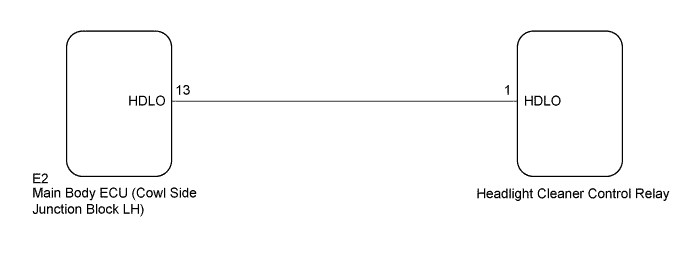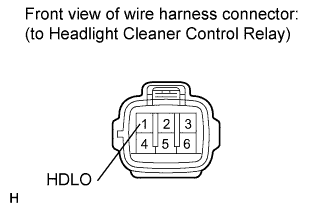Wiper And Washer System (W/ Rain Sensor) - Headlight Signal Circuit
DESCRIPTION
WIRING DIAGRAM
INSPECTION PROCEDURE
CHECK LOW BEAM HEADLIGHTS OPERATION
CHECK HARNESS AND CONNECTOR (HEADLIGHT CLEANER CONTROL RELAY - MAIN BODY ECU)
CHECK MAIN BODY ECU (COWL SIDE JUNCTION BLOCK LH)
WIPER AND WASHER SYSTEM (w/ Rain Sensor) - Headlight Signal Circuit
DESCRIPTION
The headlight cleaner control relay detects the low beam headlights status.
WIRING DIAGRAM

INSPECTION PROCEDURE
| 1.CHECK LOW BEAM HEADLIGHTS OPERATION |
Check that the low beam headlights operate normally ().
- OK:
- Low beam headlights operate normally.
| 2.CHECK HARNESS AND CONNECTOR (HEADLIGHT CLEANER CONTROL RELAY - MAIN BODY ECU) |
Disconnect the E2 main body ECU (cowl side junction block LH) connector.
Disconnect the headlight cleaner control relay connector.
Measure the resistance according to the value(s) in the table below.
- Standard Resistance:
| Tester Connection | Condition | Specified Condition |
| 1 (HDLO) - E2-13 (HDLO) | Always | Below 1 Ω |
| 1 (HDLO) - Body ground | Always | 10 kΩ or higher |
| | REPAIR OR REPLACE HARNESS OR CONNECTOR |
|
|
| 3.CHECK MAIN BODY ECU (COWL SIDE JUNCTION BLOCK LH) |
Disconnect the headlight cleaner control relay connector.
Measure the voltage according to the value(s) in the table below.
- Standard Voltage:
| Tester Connection | Switch Condition | Specified Condition |
| 1 (HDLO) - Body ground | Engine switch on (IG)
Headlight dimmer switch in HEAD | 11 to 14 V |
| 1 (HDLO) - Body ground | Engine switch on (IG)
Headlight dimmer switch not in HEAD | Below 1 V |
| | REPLACE MAIN BODY ECU (COWL SIDE JUNCTION BLOCK LH) |
|
|
| OK | |
| |
| PROCEED TO NEXT SUSPECTED AREA SHOWN IN PROBLEM SYMPTOMS TABLE ()
|
|


